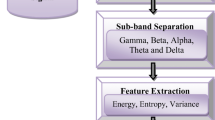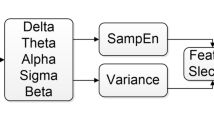Abstract
Sleep apnea syndrome (SAS) is prevalent in individuals and recently, there are many studies focus on using simple and efficient methods for SAS detection instead of polysomnography. However, not much work has been done on using nonlinear behavior of the electroencephalogram (EEG) signals. The purpose of this study is to find a novel and simpler method for detecting apnea patients and to quantify nonlinear characteristics of the sleep apnea. 30 min EEG scaling exponents that quantify power-law correlations were computed using detrended fluctuation analysis (DFA) and compared between six SAS and six healthy subjects during sleep. The mean scaling exponents were calculated every 30 s and 360 control values and 360 apnea values were obtained. These values were compared between the two groups and support vector machine (SVM) was used to classify apnea patients. Significant difference was found between EEG scaling exponents of the two groups (p < 0.001). SVM was used and obtained high and consistent recognition rate: average classification accuracy reached 95.1 % corresponding to the sensitivity 93.2 % and specificity 98.6 %. DFA of EEG is an efficient and practicable method and is helpful clinically in diagnosis of sleep apnea.



Similar content being viewed by others
References
American Academy of Sleep Medicine. Sleep-related breathing disorders in adults: recommendations for symptom definition and measurement techniques in clinical trials. Sleep. 1999;22:667–89.
Al-Angari HM, Sahakian AV. Automated recognition of obstructive sleep apnea syndrome using support vector machine classifier. IEEE Trans Inf Technol Biomed. 2012;16(3):463–8.
Belo D, Coito AL, Paiva T, Sanches JM. Topographic EEG brain mapping before, during and after obstructive sleep apnea episodes. In: 2011 IEEE international symposium on biomedical imaging: from nano to macro; 2011, p. 1860–3.
Young T, Evans L, Finn L, Palta M. Estimation of the clinically diagnosed proportion of sleep apnea syndrome in middleaged men and women. Sleep. 1997;20(9):705–6.
Álvarez-Estévez D, Moret-Bonillo V. Fuzzy reasoning used to detect apneic events in the sleep apnea-hypopnea syndrome. Expert Syst Appl. 2009;36(4):7778–85.
Practice Committee of the American Sleep Disorders Association. Practice parameters for the indications for polysomnography and related procedures. Sleep. 1997;20:406–22.
Sezgin N, Kirbas G, Akin M. The correlation analysis between airflow and oxygen saturation in obstructive sleep apnea events using correlation function. In: 2007 IEEE 15th signal processing and communications applications, SIU; 2007, p. 1–5.
Yadollahi A, Giannouli E, Moussavi Z. Sleep apnea monitoring and diagnosis based on pulse oximetery and tracheal sound signals. Med Biol Eng Comput. 2010;48:1087–97.
Al-Abed M, Manry M, Burk JR, Lucas EA, Behbehani K. A method to detect obstructive sleep apnea using neural network classification of time–frequency plots of the heart rate variability. In: Annual international conference of the IEEE engineering in medicine and biology-proceedings; 2007, p. 6101–4.
Al-Angari HM, Sahakian AV. Use of sample entropy approach to study heart rate variability in obstructive sleep apnea syndrome. IEEE Trans Biomed Eng. 2007;54(10):1900–4.
Garrett D, Peterson DA, Anderson CW, Thaut MH. Comparison of linear, nonlinear, and feature selection methods for EEG signal classification. IEEE Trans Neural Syst Rehabil Eng. 2003;11(2):141–4.
Abdullah H, Maddage NC, Cosic I, Cvetkovic D. Cross-correlation of EEG frequency bands and heart rate variability for sleep apnoea classification. Med Biol Eng Comput. 2010;48:1261–9.
Karmakar CK, Khandoker AH, Palaniswami M. Power spectral analysis of ECG signals during obstructive sleep apnoea hypopnoea epochs. In: Intelligent sensors, sensor networks and information; 2007, p. 573–6.
Khandoker AH, GubbI J, Palaniswami M. Recognizing central and obstructive sleep apnea events from normal breathing events in ECG recordings. Comput Cardiol. 2008;35:681–4.
Khandoker AH, Palaniswami M, Karmakar CK. Support vector machines for automated recognition of obstructive sleep apnea syndrome from ECG recordings. IEEE Trans Biomed Eng. 2009;13(1):37–48.
Penzel T, Kantelhardt JW, Grote L, Peter JH, Bunde A. Comparison of detrended fluctuation analysis and spectral analysis for heart rate variability in sleep and sleep apnea. IEEE Trans Biomed Eng. 2003;50(10):1143–51.
de Chazal P, Heneghan C, Sheridan E, Reilly R, Nolan P, O’Malley M. Automated processing of the single-lead electrocardiogram for the detection of obstructive sleep apnoea. IEEE Trans Biomed Eng. 2003;50(6):686–96.
Jarvis MR, Mitra PP. Apnea patients characterized by 0.02 Hz peak in the multitaper spectrogram of electrocardiogram signals. Comput Cardiol. 2000;27:769–72.
Khandoker AH, Karmakar CK, Palaniswami M. Automated recognition of patients with obstructive sleep apnoea using wavelet-based features of electrocardiogram recordings. Comput Biol Med. 2009;39:88–96.
Schonwald SV, de Santa-Helena EL, Rossatto R, Chaves ML, Gerhardt GJ. Benchmarking matching pursuit to find sleep spindles. J Neurosci Methods. 2006;156(1–2):314–21.
Schönwald SV, Carvalho DZ, de Santa-Helena EL, Lemke N, Gerhardt JL. Topography-specific spindle frequency changes in obstructive sleep apnea. BMC Neurosci. 2012;13:89.
Acır N, Güzeliş C. Automatic recognition of sleep spindles in EEG by using artificial neural networks. Expert Syst Appl. 2004;27(3):451–8.
Cabrero-Canosa M, Castro-Pereiro M, Grana-Ramos M, Hernandez-Pereira E, Moret-Bonillo V, Martin-Egana M, et al. An intelligent system for the detection and interpretation of sleep apneas. Expert Syst Appl. 2003;24(4):335–49.
Culebras A. Clinical handbook of sleep disorders. London: Butterworth-Heinemann; 1996.
Duman F, Erdamar A, Erogul O, Telatar Z, Yetkin S. Efficient sleep spindle detection algorithm with decision tree. Expert Syst Appl. 2009;36(6):9980–5.
Hwa RC, Ferree TC. Scaling properties of fluctuations in the human electroencephalogram. Phys Rev E. 2002;66:021901–8.
Goldberger AL, Amaral LAN, Glass L, Hausdorff JM, Ivanov PCh, Mark RG, Mietus JE, Moody GB, Peng C-K, Stanley HE. PhysioBank, PhysioToolkit, and PhysioNet: components of a new research resource for complex physiologic signals. Circulation. 2000;101(23):e215–e220. http://circ.ahajournals.org/cgi/content/full/101/23/e215.
Peng CK, Buldyrev SV. Finite-size efforts on long-range correlations: implications for analyzing DNA sequences. Phys Rev E. 1993;47:3730–3.
Peng CK, Havlin S, Stanley HE, Goldberger AL. Quantification of scaling exponents and crossover phenomena in nonstationary heartbeat time series. Chaos. 1995;5(1):82–7.
Peng CK, Buldyrev SV, Goldberger AL, Havlin S, Mantegna RN, Simons M, Stanley HE. Statistical properties of DNA sequences. Phys A. 1995;221:180–92.
Zhuang XT, Huang XY, Sha YL. Research on the fractal structure in the Chinese stock market. Phys A. 2004;333:293–305.
Bunde A, Havlin S, Kantel JW, Penzel T, Peter JH, Voigt K. Correlated and uncorrelated regions in heart-rate fluctuations during sleep. Phys Rev Lett. 2000;85(17):3736–9.
Kantelhardt JW, Koscielny-Bunde E, Rego HHA, Havlin S, Bunde A. Detecting long-range correlations with detrended fluctuation analysis. Phys A. 2001;295:441–54.
Ebrahimi F, Setarehdan SK, Nazeran H. DFA- and DWT-based features of HRV signal for automatic sleep staging. In: 19th Iranian conference of biomedical engineering, ICBME; 2012, p. 335–8.
Lee J-M, Kim D-J, Kim I-Y, Park K-S, Kim SI. Detrended fluctuation analysis of EEG in sleep apnea using MIT = BIH polysomnography data. Comput Biol Med. 2002;32:37–47.
Lee J-M, Kim D-J, Kim I-Y, Park KS, Kim SI. Nonlinear-analysis of human sleep EEG using detrended fluctuation analysis. Med Eng Phys. 2004;26:773–6.
Farag AF, Metwally SM, Morsy AAA. Automated sleep staging using detrended fluctuation analysis of sleep EEG. Adv Intell Syst Comput. 2013;195:501–10.
Bachmann M, Suhhova A, Lass J, Aadamsoo K, Võhma Ü, Hinrikus H. Detrended fluctuation analysis of EEG in depression. IFMBE Proc. 2014;41:694–7.
Lee JS, Yang BH, Lee JH, et al. Detrended fluctuation analysis of resting EEG in depressed outpatients and healthy controls. Clin Neurophysiol. 2007;118(11):2489–96.
Hosseinifard B, Moradi MH, Rostami R. Classifying depression patients and normal subjects using machine learning techniques and nonlinear features from EEG signal. Comput Methods Programs Biomed. 2012;109(3):339–45.
Penzel T, Kantelhardt JW, Grote L, Peter J-H, Bunde A. Comparison of detrended fluctuation analysis and spectral analysis for heart rate variability in sleep and sleep apnea. IEEE Trans Biomed Eng. 2003;50:1143–51.
Cortes C, Vapnik VN. Support vector networks. Mach Learn. 1995;20:273–97.
Kai F, Jianfeng Q, Chai Y, Dong Y. Classification of seizure based on the time–frequency image of EEG signals using HHT and SVM. Biomed Signal Process Control. 2014;13:15–22.
Erazo L, Ríos SA. A benchmark on automatic obstructive sleep apnea screening algorithms in children. Proc Comput Sci. 2014;35:739–46.
Acknowledgments
This work was supported by the Fundamental Research Funds for the Central Universities and Science and Technology Program of Guangzhou.
Conflict of interest
The authors declare that they have no conflict of interest.
Author information
Authors and Affiliations
Corresponding author
Rights and permissions
About this article
Cite this article
Zhou, J., Wu, Xm. & Zeng, Wj. Automatic detection of sleep apnea based on EEG detrended fluctuation analysis and support vector machine. J Clin Monit Comput 29, 767–772 (2015). https://doi.org/10.1007/s10877-015-9664-0
Received:
Accepted:
Published:
Issue Date:
DOI: https://doi.org/10.1007/s10877-015-9664-0




